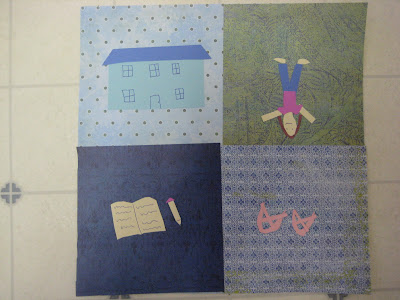We have studied quilt patterns as an art project in our history coop. However, mostly we study the quilt patterns from European cultures. African Americans, including (and, unfortunately, primarily) slaves, also made quilts during the 17th-19th century. But because the slave quilts were used so much, relatively few of them have survived to modern times.
However, by looking at those that have lasted, along with studying the African American stories, it appears that there were significant differences between quilts made by the African Americans around the time of the Civil War and those of the white cultures.
First of all, there was the reality of quilts made by slaves that they generally only received the worst scraps of fabrics from their white owners. Thus, they didn't necessarily have the ability to plan color-coordinated quilts using large amounts of the same materials.
Secondly, many African American quilts drew their designs from African traditions of textile designs, rather than the white American approach. Some of those African traditions included:
- bold and contrasting colors
- asymmetric patterns (rather than the symmetric patterns preferred by European/American cultures)
- lots of different patterns (apparently the ruling Africans showed their wealth/power by wearing fabrics woven with lots of different patterns, so different patterns were a sign of status within some African cultures)
- irregular patterns that break straight lines (apparently some African tribes believed that bad spirits traveled in straight lines, so rather than maintaining a straight pattern that would create a straight line, they would interrupt the pattern and break the straight line, which was supposed to disperse the bad spirits)
Perhaps most importantly, however, is that the finest African American quilts that have survived suggest that blacks of that time created appliques story quilts. Here are two examples of biblical story quilts from a freed slave quilt artist of the late 19th century, Harriet Powers:
When I asked my students why the slaves would have created story quilts, none of them got all of the potential answers quite right. However, we assume these quilts were created because:
- To continue the African (but really universal) tradition of oral storytelling
- Because most slaves were not allowed to learn to read and write (in order to reduce their ability to protest or to escape their slavery), this was the best way to capture their lives and their stories
- When families were split up, this was one way to remind a lost spouse, sibling, or child of their family or place of origin (since they weren't able to write or send photographs)
So for our hands-on activity in this lesson, we created paper quilts out of scrapbook and other paper. Each student was supposed to make a square that was an example of either African American quilt patterns or that was a story quilt. Some examples are below:
As usual, the results were unique and creative, while still demonstrating an understanding of the lesson.







Thanks. Nice idea. How long did this lesson take?
ReplyDeleteTalking about the African American quilts could go longer, of course, but can be covered in about 15 minutes. Because we are using paper, the actual quilt making can be relatively quick. I would say it took a minimum of 15 minutes to make 4 squares, and maybe double that for those who had more elaborate patterns and/or who took more care on their work.
ReplyDeleteSo I would recommend scheduling it for an hour to give both the teacher and the students some flex time, although it can be done in 30-45 minutes if necessary.
Really helpful! Thank you
ReplyDeleteThis is beautiful, I think I am going to incorporate this idea into my black history studies this year. Thank you so much for sharing.
ReplyDeleteI'm creating a lesson for Zoom on Harriet Powers right now so I was very excited to find this post-- Does anyone know of a good source of images for other examples?
ReplyDelete